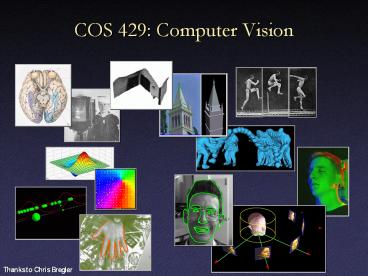COS 429: Computer Vision - PowerPoint PPT Presentation
Title:
COS 429: Computer Vision
Description:
COS 429: Computer Vision Thanks to Chris Bregler – PowerPoint PPT presentation
Number of Views:137
Avg rating:3.0/5.0
Title: COS 429: Computer Vision
1
COS 429 Computer Vision
Thanks to Chris Bregler
2
COS 429 Computer Vision
- Instructor Szymon Rusinkiewicz
smr_at_cs.princeton.edu - TA Nathaniel Dirksen ndirksen_at_cs.princeton.e
du - Course web page http//www.cs.princeton.edu/cours
es/cs496/
3
What is Computer Vision?
- Input images or video
- Output description of the world
- But also measuring, classifying, interpreting
visual information
4
Low-Level or Early Vision
- Considers local properties of an image
Theres an edge!
5
Mid-Level Vision
- Grouping and segmentation
Theres an object and a background!
6
High-Level Vision
- Recognition
Its a chair!
7
Big Question 1 Who Cares?
- Applications of computer vision
- In AI vision serves as the input stage
- In medicine understanding human vision
- In engineering model extraction
8
Vision and Other Fields
Computer Vision
9
Big Question 2 Does It Work?
- Situation much the same as AI
- Some fundamental algorithms
- Large collection of hacks / heuristics
- Vision is hard!
- Especially at high level, physiology unknown
- Requires integrating many different methods
- Requires reasoning and understandingAI
completeness
10
Computer and Human Vision
- Emulating effects of human vision
- Understanding physiology of human vision
- Analogues of human vision atlow, mid, and high
levels
11
Image Formation
- Human lens forms image on retina,sensors (rods
and cones) respond to light - Computer lens system forms image,sensors (CCD,
CMOS) respond to light
12
Low-Level Vision
Hubel
13
Low-Level Vision
- Retinal ganglion cells
- Lateral Geniculate Nucleus function
unknown(visual adaptation?) - Primary Visual Cortex
- Simple cells orientational sensitivity
- Complex cells directional sensitivity
- Further processing
- Temporal cortex what is the object?
- Parietal cortex where is the object? How do I
get it?
14
Low-Level Vision
- Net effect low-level human visioncan be
(partially) modeled as a set ofmultiresolution,
oriented filters
15
Low-Level Depth Cues
- Focus
- Vergence
- Stereo
- Not as important as popularly believed
16
Low-Level Computer Vision
- Filters and filter banks
- Implemented via convolution
- Detection of edges, corners, and other local
features - Can include multiple orientations
- Can include multiple scales filter pyramids
- Applications
- First stage of segmentation
- Texture recognition / classification
- Texture synthesis
17
Texture Analysis / Synthesis
Multiresolution Oriented Filter Bank
OriginalImage
Image Pyramid
18
Texture Analysis / Synthesis
Original Texture
Synthesized Texture
Heeger and Bergen
19
Low-Level Computer Vision
- Optical flow
- Detecting frame-to-frame motion
- Local operator looking for gradients
- Applications
- First stage of tracking
20
Optical Flow
Image 1
Optical FlowField
Image 2
21
Low-Level Computer Vision
- Shape from X
- Stereo
- Motion
- Shading
- Texture foreshortening
22
3D Reconstruction
TomasiKanade
Forsyth et al.
Phigin et al.
Debevec,Taylor,Malik
23
Mid-Level Vision
- Physiology unclear
- Observations by Gestalt psychologists
- Proximity
- Similarity
- Common fate
- Common region
- Parallelism
- Closure
- Symmetry
- Continuity
- Familiar configuration
Wertheimer
24
Grouping Cues
25
Grouping Cues
26
Grouping Cues
27
Grouping Cues
28
Mid-Level Computer Vision
- Techniques
- Clustering based on similarity
- Limited work on other principles
- Applications
- Segmentation / grouping
- Tracking
29
Snakes Active Contours
Contour Evolution forSegmenting an Artery
30
Histograms
Birchfeld
31
Expectation Maximization (EM)
Color Segmentation
32
Bayesian Methods
- Prior probability
- Expected distribution of models
- Conditional probability P(AB)
- Probability of observation Agiven model B
33
Bayesian Methods
- Prior probability
- Expected distribution of models
- Conditional probability P(AB)
- Probability of observation Agiven model B
- Bayess Rule P(BA) P(AB) ? P(B) / P(A)
- Probability of model B given observation A
Thomas Bayes (c. 1702-1761)
34
Bayesian Methods
black pixels
black pixels
35
High-Level Vision
- Human mechanisms ???
36
High-Level Vision
- Computational mechanisms
- Bayesian networks
- Templates
- Linear subspace methods
- Kinematic models
37
Template-Based Methods
Cootes et al.
38
Linear Subspaces
39
Principal Components Analysis (PCA)
Data
New Basis Vectors
PCA
Kirby et al.
40
Kinematic Models
- Optical Flow/Feature tracking no constraints
- Layered Motion rigid constraints
- Articulated kinematic chain constraints
- Nonrigid implicit / learned constraints
41
Real-world Applications
Osuna et al
42
Real-world Applications
Osuna et al
43
Course Outline
- Image formation and capture
- Filtering and feature detection
- Motion estimation
- Segmentation and clustering
- PCA
- 3D projective geometry
- Shape acquisition
- Shape analysis
44
3D Scanning
45
Image-Based Modeling and Rendering
Debevec et al.
Manex
46
Course Mechanics
- 65 4 written / programming assignments
- 35 Final group project
47
Course Mechanics
- BookIntroductory Techniques for 3-D Computer
VisionEmanuele Trucco and Alessandro Verri - Papers
48
COS 429 Computer Vision
- Instructor Szymon Rusinkiewicz
smr_at_cs.princeton.edu - TA Nathaniel Dirksen ndirksen_at_cs.princeton.e
du - Course web page http//www.cs.princeton.edu/cours
es/cs496/































